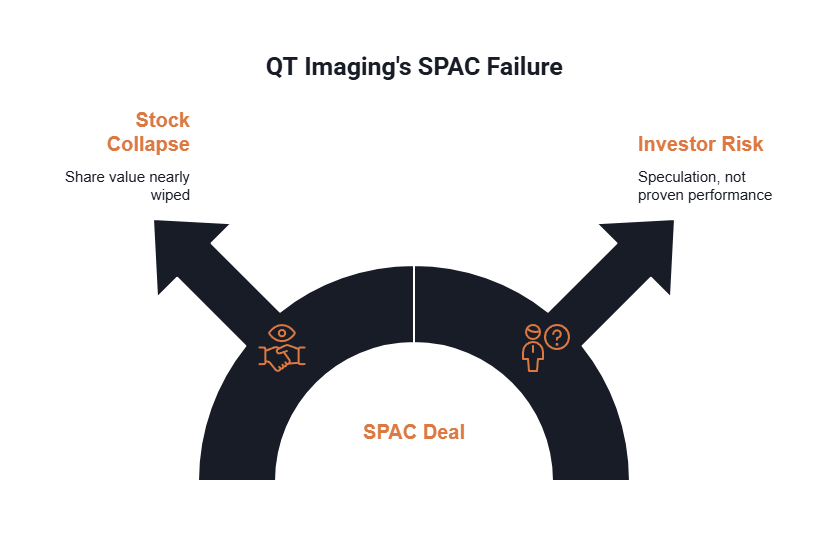The collapse of QT Imaging (OTC: QTIH) has left investors facing staggering financial losses. Reports suggest that more than 15,000 investors were affected, with combined losses exceeding $200 million. Following its SPAC (Special Purpose Acquisition Company) transaction, QT Imaging’s stock plunged 97% in less than a week — dropping from $11.11 per share on February 29, 2024, to just $1.35 by March 5, 2024.
For those who trusted brokers and advisors to guide them, the fallout has shown the dangers of speculative investments that are marketed without sufficient transparency. If you or someone you know has been impacted by an unsuitable investment through a broker, don’t hesitate to reach out to Meyer Wilson Werning today. Our attorneys are experienced in broker misconduct cases and will help to guide you through the process with a free consultation.

How QT Imaging’s SPAC Offering Unraveled
Initially positioned as an innovative healthcare device company, QT Imaging promoted high-resolution imaging solutions enhanced by artificial intelligence. Its SPAC deal — underwritten by Oppenheimer — was touted as a chance for investors to get in early on a company with transformative potential. The involvement of a major underwriter created an impression of legitimacy and rigorous due diligence, which made many investors feel secure.
The reality was very different. Once public, QT Imaging quickly failed to meet its lofty projections. The stock’s near-total collapse demonstrated how little foundation existed beneath the marketing. Investors who were encouraged by financial advisors to participate in the SPAC offering were essentially betting on speculation, not proven performance.
We Have Recovered Over
$350 Million for Our Clients Nationwide.
Investor Losses and What They Reveal
QT Imaging’s swift decline was more than just a poor market performance — it exposed the risks tied to emerging companies with untested products and highlighted failures in how these investments were recommended. Many investors believed they were entering a growth opportunity, only to watch their portfolios collapse within days.
The severity of these losses — almost complete in many cases — raises deeper issues about broker responsibility. When a firm like Oppenheimer underwrites a deal, investors naturally expect a high standard of due diligence. Instead, the events surrounding QT Imaging suggest that marketing and optimism were prioritized over realistic assessments of risk.
The Responsibilities of Brokers and Underwriters
Brokers and brokerage firms have binding obligations under Regulation Best Interest (Reg BI). They must evaluate investments carefully, communicate risks clearly, and ensure that recommendations align with each client’s risk tolerance and financial goals.
In the case of QT Imaging, several concerns stand out:
- Due diligence gaps: Advisors may have relied too heavily on underwriter marketing materials without conducting independent research.
- Conflicts of interest: Because Oppenheimer underwrote the offering, questions remain about whether affiliated advisors promoted the stock despite its risks.
- Suitability failures: Many investors who lost money were not high-risk speculators, raising concerns that recommendations were unsuitable.
These shortcomings reflect not just individual failings but broader structural issues in how speculative SPAC offerings are brought to retail investors.
For more on the Regulation Best Interest standard, check out our video below:
Our lawyers are nationwide leaders in investment fraud cases.
Legal Options for Affected Investors
For those who lost money in QT Imaging, there may be legal claims to pursue against brokers, brokerage firms, or even underwriters. Potential claims include:
- Negligence or breach of duty: Where brokers failed to properly assess or disclose risks.
- Misrepresentation or omission: If advisors downplayed the speculative nature of the investment.
- Regulatory violations: Failure to uphold obligations under Reg BI or FINRA rules.
Arbitration is often the required path for recovery, offering investors the ability to present evidence before a neutral arbitrator. Documentation such as account records, marketing communications, and internal notes from advisors may be critical in building a case.
We Are The firm other lawyers
call for support.
Meyer Wilson Werning’s Call for Transparency and Accountability
The QT Imaging debacle illustrates why transparency and accountability are critical in the financial industry. SPAC offerings can generate excitement, but without meaningful scrutiny, they expose investors to devastating risks. Regulators like FINRA must continue enforcing Reg BI, and brokerage firms must put client interests ahead of commissions and marketing hype.
At Meyer Wilson Werning, we represent investors harmed by speculative offerings like QT Imaging. If you suffered losses, contact our team so we can help you assess whether your broker or brokerage firm may be liable and explore your legal options for recovery.
Frequently Asked Questions

Why did QT Imaging’s stock collapse after its SPAC merger?
QT Imaging’s stock dropped 97% within a week because its financial performance failed to match the lofty projections promoted during its SPAC deal. The company quickly showed it lacked the foundation to support its valuation.
How much money did investors lose in QT Imaging?
Reports estimate that more than 15,000 investors lost over $200 million. Many saw their portfolios nearly wiped out as the stock fell from $11.11 to $1.35 in just days.
What role did Oppenheimer play in QT Imaging’s SPAC offering?
Oppenheimer underwrote QT Imaging’s SPAC deal, which gave the offering an appearance of legitimacy. However, underwriting does not guarantee strong due diligence or protection from risk. In fact, underwriting can often lead to conflicts of interest.
Can brokers be held responsible for QT Imaging investment losses?
Yes, brokers must comply with Regulation Best Interest and ensure investments are suitable for each client. If they failed to disclose risks or misrepresented the stock, investors may have valid claims.
What legal options are available to QT Imaging investors?
Investors may pursue arbitration claims for negligence, misrepresentation, or regulatory violations. Arbitration allows them to present evidence and seek recovery directly from brokers or firms.
Recovering Losses Caused by Investment Misconduct.

